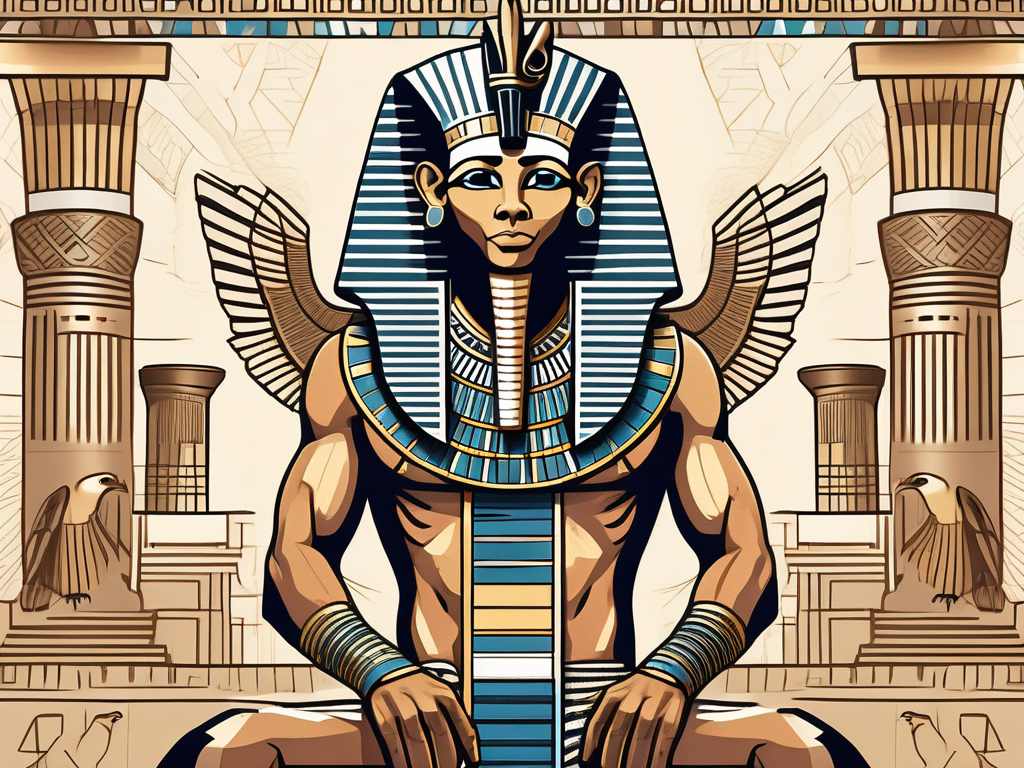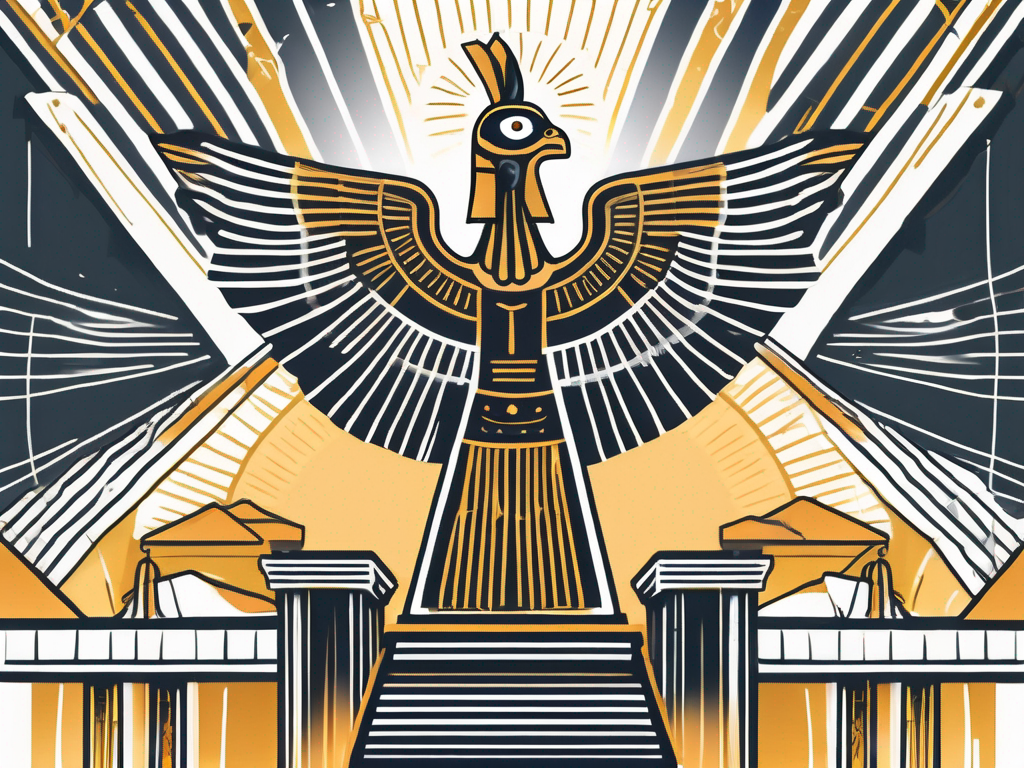Welcome to our exploration of Qebehsenuef, the fascinating Egyptian god shrouded in mystery. In this article, we will delve into the various aspects of Qebehsenuef’s identity, symbolism, rituals, temples, and even his lasting impact on modern culture. Prepare to uncover the hidden secrets and ancient wisdom surrounding this captivating deity.
Understanding Qebehsenuef: An Introduction
Let’s begin our journey by gaining a better understanding of who Qebehsenuef truly is. In Egyptian mythology, Qebehsenuef is one of the four sons of Horus, the falcon-headed god. As one of the protectors of the canopic jars, Qebehsenuef played a crucial role in preserving the organs of the deceased during the mummification process.
Qebehsenuef’s significance in Egyptian mythology cannot be overstated. He was believed to oversee the protection of the intestines, which were carefully removed and stored in a canopic jar. This act served as a crucial step in the journey to the afterlife, ensuring the deceased’s continued existence beyond the earthly realm.
As an important guardian, Qebehsenuef has left an indelible mark on ancient Egyptian beliefs and rituals, shaping their understanding of the afterlife and the preservation of the physical body.
One cannot discuss Qebehsenuef without mentioning his deep connection to the canopic jars. Each of the four sons of Horus was believed to oversee a specific organ: Imsety protected the liver, Hapi guarded the lungs, Duamatef preserved the stomach, and Qebehsenuef had dominion over the intestines.
These intricate vessels, intricately adorned and often placed within the pharaoh’s tomb, were instrumental in the process of mummification. Qebehsenuef’s presence in this sacred practice cannot be understated, as his watchful eye ensured the safe passage into the afterlife.
The Symbolism of Qebehsenuef
Qebehsenuef’s association with the canopic jars goes beyond his role as a guardian of the intestines. The canopic jars themselves hold great symbolic significance in ancient Egyptian culture. The four sons of Horus, including Qebehsenuef, were not only protectors of the organs but also representatives of the four cardinal points.
Imsety, Hapi, Duamatef, and Qebehsenuef were believed to embody the north, east, south, and west, respectively. This connection to the cardinal points further emphasized their role as guardians and protectors, ensuring the deceased’s safe journey into the afterlife from all directions.
Furthermore, Qebehsenuef’s depiction as a falcon-headed deity also carries symbolic weight. In ancient Egyptian mythology, the falcon was associated with the sun god, Ra. As a falcon-headed god, Qebehsenuef’s connection to Ra signifies his role in guiding the deceased towards the eternal light of the sun, a symbol of rebirth and renewal.
Qebehsenuef’s presence in Egyptian mythology extends beyond his association with the canopic jars and his symbolic representation. He is also believed to have played a role in the judgment of the deceased’s heart in the afterlife. Alongside his brothers, Qebehsenuef would assist in the weighing of the heart against the feather of Ma’at, the goddess of truth and justice.
This judgment process, known as the “Weighing of the Heart,” determined whether the deceased had lived a righteous life and was deserving of eternal life. Qebehsenuef’s involvement in this crucial moment showcases his importance in the journey to the afterlife and the ultimate fate of the deceased.
The Symbolism of Qebehsenuef
Now, let’s explore the symbolic representation of Qebehsenuef and the powerful imagery associated with him.
Qebehsenuef, one of the four sons of Horus, played a crucial role in ancient Egyptian mythology. As the protector of the canopic jar containing the intestines, he symbolized the preservation of life and the continuity of the soul in the afterlife.
Qebehsenuef and the Hawk: A Powerful Symbol
A prominent symbol of Qebehsenuef is the hawk, which represents both vigilance and protection. The hawk’s keen eyesight mirrored Qebehsenuef’s role in overseeing the canopic jars and ensuring the organs’ preservation.
Moreover, the hawk’s association with Horus, Qebehsenuef’s divine father, highlights his connection to the royal lineage and divine protection. This symbolism showcases Qebehsenuef’s importance in the grand narrative of ancient Egyptian mythology.
Furthermore, the hawk’s ability to soar high in the sky symbolizes Qebehsenuef’s transcendence and his ability to guide the deceased through their journey to the afterlife. Just as the hawk’s wings carry it effortlessly through the air, Qebehsenuef’s guidance provides comfort and assurance to the souls making their way to the realm of the dead.
The Significance of the West in Qebehsenuef’s Iconography
In the visual representations of Qebehsenuef, we often find him depicted facing the west. This particular direction held great significance in ancient Egyptian belief systems, as it was associated with the realm of the dead.
Qebehsenuef’s positioning highlights his role as a guide and guardian during the transition from the physical world to the afterlife. By facing the west, he encapsulates the hope and reassurance that the deceased would find eternal peace and happiness.
Additionally, the west was believed to be the place where the sun set, symbolizing the end of the day and the journey into the night. Qebehsenuef’s presence in this direction signifies his role in guiding the deceased through the darkness of the afterlife and into the eternal light.
Furthermore, the west was associated with the god Osiris, the ruler of the underworld. Qebehsenuef’s alignment with this direction solidifies his connection to the realm of the dead and his role in assisting the souls in their journey towards Osiris’ judgment.
Overall, the symbolism of Qebehsenuef and the imagery associated with him reveal the ancient Egyptians’ deep belief in the afterlife and the importance of preservation and guidance in ensuring a successful transition to the realm of the dead.
Qebehsenuef in Ancient Egyptian Rituals
Let us now delve into the rituals in which Qebehsenuef played a crucial part, shedding light on the important role he fulfilled in the ancient Egyptian funerary customs.
Qebehsenuef, one of the four sons of Horus, held a significant position in the intricate and sacred rituals of ancient Egyptian culture. His divine presence and watchful eye ensured the proper preservation of the deceased’s physical body, as well as their safe passage into the afterlife.
The Role of Qebehsenuef in Mummification
Mummification, a complex and sacred process in ancient Egyptian culture, involved preparing the deceased for their journey into the afterlife. Among the many steps, Qebehsenuef held a vital position in ensuring the preservation of the intestines, an integral part of the mummification process.
Qebehsenuef, with his falcon head and human body, was responsible for guarding the canopic jar that contained the intestines. This task required utmost precision and care, as the successful preservation of the organs was crucial for the deceased’s journey into the divine realm.
His divine watch over the canopic jars and the organs they contained reflected the Egyptians’ profound reverence for the physical body and their belief in its preservation for the afterlife. The meticulous process of mummification, overseen by Qebehsenuef, ensured that the deceased’s body would remain intact and ready for the spiritual journey that awaited them.
Qebehsenuef’s Influence on Afterlife Beliefs
Qebehsenuef’s role extended beyond the realm of mummification. His participation in the rituals surrounding the deceased was instrumental in shaping ancient Egyptian beliefs about the afterlife.
The ancient Egyptians firmly believed in the continuity of life and the existence of a divine realm beyond our own. Qebehsenuef’s presence and involvement in the rituals surrounding death served as a powerful reminder of this belief.
The idea of preserving the physical body and ensuring the safe passage into the realm of the dead demonstrated a deep-seated belief in the continuity of life and the existence of a divine realm beyond our own. Qebehsenuef’s role in these rituals reinforced the Egyptians’ faith in the afterlife and their commitment to preparing the deceased for their eternal journey.
Qebehsenuef’s influence on afterlife beliefs was not limited to the preservation of the physical body. His divine presence also symbolized the protection and guidance that the deceased would receive in the divine realm. The ancient Egyptians believed that Qebehsenuef, along with his brothers, would assist the deceased in navigating the challenges and trials of the afterlife, ensuring their safe arrival to their final resting place.
In conclusion, Qebehsenuef’s role in ancient Egyptian rituals was of utmost importance. From his involvement in the mummification process to his influence on afterlife beliefs, Qebehsenuef played a vital role in ensuring the proper preservation and spiritual journey of the deceased. His divine presence and watchful eye served as a reminder of the Egyptians’ deep-seated belief in the continuity of life and the existence of a divine realm beyond our own.
The Temples and Artifacts of Qebehsenuef
Now, let’s explore the physical manifestations of Qebehsenuef’s worship—his temples and the artifacts created in his honor.
Qebehsenuef’s Presence in Ancient Egyptian Art
The rich artistic tradition of ancient Egypt serves as a testament to the importance of Qebehsenuef in their society. Paintings, sculptures, and reliefs showcasing the god’s likeness can be found in tombs, temples, and sacred spaces throughout the Nile Valley.
These artistic representations offer a glimpse into the beliefs, traditions, and rituals associated with Qebehsenuef’s worship, allowing us to better understand the reverence and significance he held in Egyptian society.
Temples and Shrines Dedicated to Qebehsenuef
Dotted throughout ancient Egypt, temples and shrines dedicated to Qebehsenuef acted as gathering places for worshippers seeking the god’s guidance and protection.
These sacred spaces, adorned with intricate carvings and beautiful artwork, provided an environment where individuals could connect with Qebehsenuef and find solace in his watchful presence. Their construction reflects the devotion and belief in the power of this revered deity.
Qebehsenuef’s Legacy in Modern Culture
Despite the passage of millennia, Qebehsenuef’s influence continues to permeate modern culture, leaving an impression on literature, film, and even our collective understanding of symbolism.
Qebehsenuef in Literature and Film
Throughout various works of literature and film, Qebehsenuef’s enigmatic persona has captivated audiences around the world. His role as a guardian of the afterlife and a symbol of protection often finds its way into fantastical narratives inspired by ancient Egyptian mythology.
From thrilling adventure novels to blockbuster movies, Qebehsenuef’s enduring legacy continues to captivate the imaginations of storytellers and audiences alike.
The Modern Relevance of Qebehsenuef’s Symbolism
Qebehsenuef’s symbolism and imagery remain a prevalent source of inspiration today. His depiction as a guardian and protector resonates with individuals seeking strength and guidance in the face of life’s challenges.
The powerful symbolism associated with Qebehsenuef serves as a reminder of the timeless universal themes of protection, preservation, and the belief in a greater existence beyond our mortal lives.
Uncovering the Mysteries of Qebehsenuef
Qebehsenuef, the Egyptian god of preservation and protection, continues to fascinate us with his rich symbolism and enduring legacy. From his role in ancient Egyptian rituals to his representation in art and modern culture, Qebehsenuef offers insight into the beliefs and aspirations of ancient civilizations.
By unraveling the mysteries surrounding Qebehsenuef, we gain a deeper understanding of our shared humanity, the eternal quest for meaning, and the enduring power of faith and symbols throughout history.
So, let us embrace the allure of Qebehsenuef, for within his enigmatic presence lies the wisdom of ancient Egypt waiting to be discovered.












